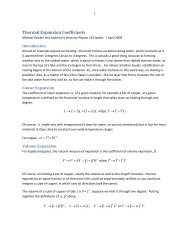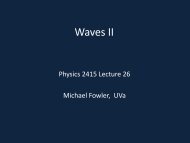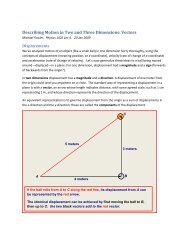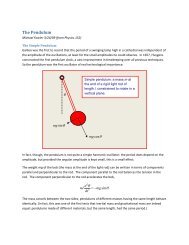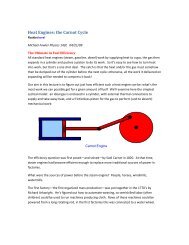r - Galileo and Einstein
r - Galileo and Einstein
r - Galileo and Einstein
- No tags were found...
Create successful ePaper yourself
Turn your PDF publications into a flip-book with our unique Google optimized e-Paper software.
Gauss’ Law <strong>and</strong> ApplicationsPhysics 2415 Lecture 5Michael Fowler, UVa
Today’s Topics• Gauss’ Law: where it came from—review• Gauss’ Law for Systems with Spherical Symmetry• Gauss’ Law for Cylindrical Systems: Coaxial Cable• Gauss’ Law for Flat Plates
Clicker Question• A charge +Q is placed a small distance d froma large flat conducting surface.• Describe the electric field lines: close to thecharge, they point radially outwards from thecharge, but as they approach the conductingplane:• A. they bend away from it.• B. they reach it <strong>and</strong> just stop.• C. they curve around to meet the plane atright angles.
• Field lines must alwaysmeet a conductor atright angles inelectrostatics.• Physically, the positivecharge has attractednegative charges in theconductor to gather inthe area under it. Theyrepel each other, so arerather spread out.Clicker Answer
Dipole Field Lines in 3D• There’s an analogy withflow of an incompressiblefluid: imagine fluidemerging from a source atthe positive charge,draining into a sink at thenegative charge.• The electric field lines arelike stream lines, showingfluid velocity direction ateach point.• Check out the applets at http://www.falstad.com/vector2de/ !
Velocity Field for a Steady Source in 3D• Imagine you’re filling a deep pool, with a hose<strong>and</strong> its end, deep in the water, is a porous ball sothe water flows out equally in all directions.• Now picture the flow through a spherical fishnet,centered on the source, <strong>and</strong> far smaller than thepool size.• Now think of a second spherical net, twice theradius of the first, so 4x the surface area. Insteady flow, total water flow across the two2spheres is the same: so v1/r.• This velocity field is identical to the electric fieldfrom a positive charge!
Total Flow through any Surface• But how do we quantify the fluidflow through such a net?• We do it one fishnet hole at a time:unlike the sphere, the flow velocityis no longer always perpendicular tothe area.• We represent each fishnet hole by avector dA, magnitude equal to its(small) area, direction perpendicularoutwards. Flow through hole is v dA• The total outward flow is v dA.netvvdAThe component of perp. tothe surface is v .vcos
What about a Closed Surface thatDoesn’t Include the Charge?• The yellow dotted line • arepresents some fixed closedsurface.• Think of the fluid picture: insteady flow, it goes in oneside, out the other. The netflow across the surface mustbe zero—it can’t pile upinside.E dA• By analogy, the charge is outside.0if
What about More than One Charge?• Remember the Principle of Superposition: theelectric field can always be written as a linearsum of contributions from individual pointcharges:E E E E from Q , Q , Q<strong>and</strong> so1 2 3 1 2 3E dA E dA E dA E dA 1 2 3will have a contribution i 0 from eachcharge inside the surface—this is Gauss’ Law.Q/
Gauss’ Law• The integral of the total electric field flux outof a closed surface is equal to the total chargeQ inside the surface divided by 0:SE dAQ0
Spherical Symmetry• First, a uniform sphericalshell, radius r 0 , of positivecharge.• The perfect sphericalsymmetry means the electricfield outside, at a distance rfrom the center, must pointradially outwards. (rotatingthe sphere doesn’t changeanything, but would changea field pointing any otherway.)• arr 0
Spherical Symmetry• The blue circle represents aspherical surface of radius r,concentric with the shell ofcharge.• For this enclosing surface,QGauss’ Law E dAS 0becomes 24 r E r Q / 0,E r140QrkQr2 2• arr 0
Spherical Symmetry• Gauss’ Law easily shows thatthe electric field from auniform shell of charge is thesame outside the shell as if allthe charge were concentratedat a point charge at the centerof the sphere. This is difficultto derive using Coulomb’sLaw!• arr 0
Field Inside a Hollow Shell of Charge• Now let’s take the enclosing surfaceinside the hollow shell of charge.• Gauss’ Law is now• aSQE dA • Because there is no charge inside theshell, it’s all on the surface.• The spherical symmetry tells us thefield inside the shell is exactly zero—again, not so simple from Coulomb’sLaw.00rr 0
Field Outside a Solid Sphere of Charge• Assume we have a sphere ofinsulator with total charge Q • adistributed uniformly through itsvolume.• The field outside is again 2E r14from the spherical symmetry.• Note: Gauss’ Law also works forgravitation—<strong>and</strong> this is theresult for a solid sphere of mass.0Qrrr 0
Field Inside a Solid Sphere of Charge• Now let’s take the enclosing surfaceinside the solid sphere of charge.• Gauss’ Law is nowSQ volume inside S Q r3inside Q 30 total volume 0 r0E dA2• From this, since E dA4r E,ESQ4rr30 0so the electric field strength increaseslinearly from zero at the center to theoutside value at the surface.• a r r 0
gClicker QuestionHow will change (if at all) on going from theEarth’s surface to the bottom of a deep mine?(Assume the Earth has uniform density.)gA. will be a bit stronger at the bottom of themineB. It will be weakerC. It will be the same as at the surface
Clicker AnswerHow will g change (if at all) on going fromthe Earth’s surface to the bottom of a deepmine?For uniform density, it will be weaker: thegravitational field strength varies in exactlythe same way as the electric field from asolid sphere with charge uniformlydistributed throughout the volume.Note: actually the density increases with depth, so things are more complicated…
Clicker Question• If you could distribute charge perfectlyuniformly throughout the volume of a solidspherical conductor, would it stay in place?A. YesB. No
Clicker Answer• If you could distribute charge perfectlyuniformly throughout the volume of a solidspherical conductor, would it stay that way?A. YesB. NoBecause this charge distribution gives rise to anonzero outward field inside the conductor—the charge would therefore flow radiallyoutwards to the surface.
Field from a Line of Charge• The field is radially outward fromthe line, which has chargedensity coul/m.• Take as gaussian surface acylinder, radius r, axis on the line:• The flat ends make zerocontribution to the surfaceintegral: the electric field vectorslie in the plane.• a• For the curved surface:Q 1 2k E dA 2 r E, E . 2r rS0 0 0
Field from a Cylinder of Charge• Taking a gaussian surface asshown, E 2 k/ r, exactly asfor a line of charge along thecenter.• a
Clicker Question• Suppose the central cylinder isa solid copper rod, carryingcharge but with no currentsanywhere.• The charge distribution will be:A. Uniformly distributed throughthe rodB. Restricted to the rod’s surfaceC. Some other distribution.• a
Clicker Answer• Suppose the central cylinder is asolid copper rod, carrying chargebut with no currents anywhere.• The charge distribution will be:Restricted to the rod’s surface!Just like the solid sphere, anycharge inside the rod will giverise to an electric field, <strong>and</strong>therefore a current, flowingoutwards.• a
Coaxial Cable Question• In a coaxial cable, a central conductioncylinder is surrounded by a cylinder ofinsulator, <strong>and</strong> that is inside a hollowconducting cylinder, which is grounded here.• If the central conductor is positively charged,the outer conducting cylinder will:A. have negative charge throughout its volumeB. Have negative charge on its outside surfaceC. Have negative charge on its inside surfaceD. Have no net charge.++ ++
Coaxial Cable Answer• In a coaxial cable, a central conductioncylinder is surrounded by a cylinder ofinsulator, <strong>and</strong> that is inside a hollowconducting cylinder, which is grounded here.• If the central conductor is positively charged,the outer conducting cylinder will:• Have negative charge on its inside surface• The electric field lines radiating out from theinner conductor must end at the innersurface—there can be no field inside themetal of the outer cylinder.++ ++
Uniform Sheet of Charge• We know from symmetry that theelectric field is perpendicularly• aoutward from the plane.• We take as gaussian surface a“pillbox”: shaped like a penny, itsround faces parallel to thesurface, one above <strong>and</strong> onebelow, area A. It contains charge(shaded red) Q A where thecharge density is C/m 2 .A• Gauss’ theorem gives 2 AE , soBoth faces contributeE 0 20
Charge on Surface of a Conductor• For a flat conducting surface, theelectric field is perpendicularly• aoutward, or a current would arise.• We have a sheet of charge on thesurface, so we take the sameGaussian pillbox as for the sheetof charge, but this time there isno electric field pointingdownwards into the conductor.• Therefore Gauss’ Law givesAAE , so E 0 0





